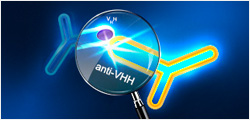| Species |
Human |
| Protein Construction |
Expressed with an N-terminal Met.
IL-20 (Leu25-Glu176)
Accession # Q9NYY1 |
|
| Purity |
> 95% as analyzed by SDS-PAGE
> 95% as analyzed by HPLC |
| Endotoxin Level |
< 1 EU/μg of protein by LAL method |
| Biological Activity |
Fully biologically active when compared to standard. The ED50 as determined by a cell proliferation assay using human IL-20Rα and human IL-20Rβ co-transfected murine BaF3 pro-B cells is less than 0.5 ng/ml, corresponding to a specific activity of > 2.0 × 106 IU/mg. |
| Expression System |
E. coli |
| Theoretical Molecular Weight |
17.6 kDa |
| Formulation |
Lyophilized from a 0.2 μm filtered solution in PBS, pH 7.2, with trehalose. |
| Reconstitution |
It is recommended that this vial be briefly centrifuged prior to opening to bring the contents to the bottom. Reconstitute the lyophilized powder in sterile distilled water or aqueous buffer containing 0.1 % BSA to a concentration of 0.1-1.0 mg/ml. |
| Storage & Stability |
Upon receiving, this product remains stable for up to 6 months at -70°C or -20°C. Upon reconstitution, the product should be stable for up to 1 week at 4°C or up to 3 months at -20°C. Avoid repeated freeze-thaw cycles. |
| Target Background |
IL-20 is a member of the IL-10 family of regulatory cytokines which includes IL-10, IL-19, IL-20, IL-22, IL-24 and IL-26. Members of this family share partial homology in their amino acid sequences but they are dissimilar in their biological functions. IL-20 is a hematopoietic growth factor capable of stimulating colony formation by CD34+ multipotential progenitors, but not by other progenitor cells. IL-20 signals through a receptor system composed of type I IL-20R-α and type II IL-20R-β. Over-expression of IL-20 in keratinocytes expressing both receptor subunits has been implicated in the induction of inflammatory skin disease. |
| Synonyms |
IL20; IL-20; IL10D; ZCYTO10; Interleukin 20 |
������ For laboratory research use only. Direct human use, including taking orally and injection and clinical use are forbidden.

































